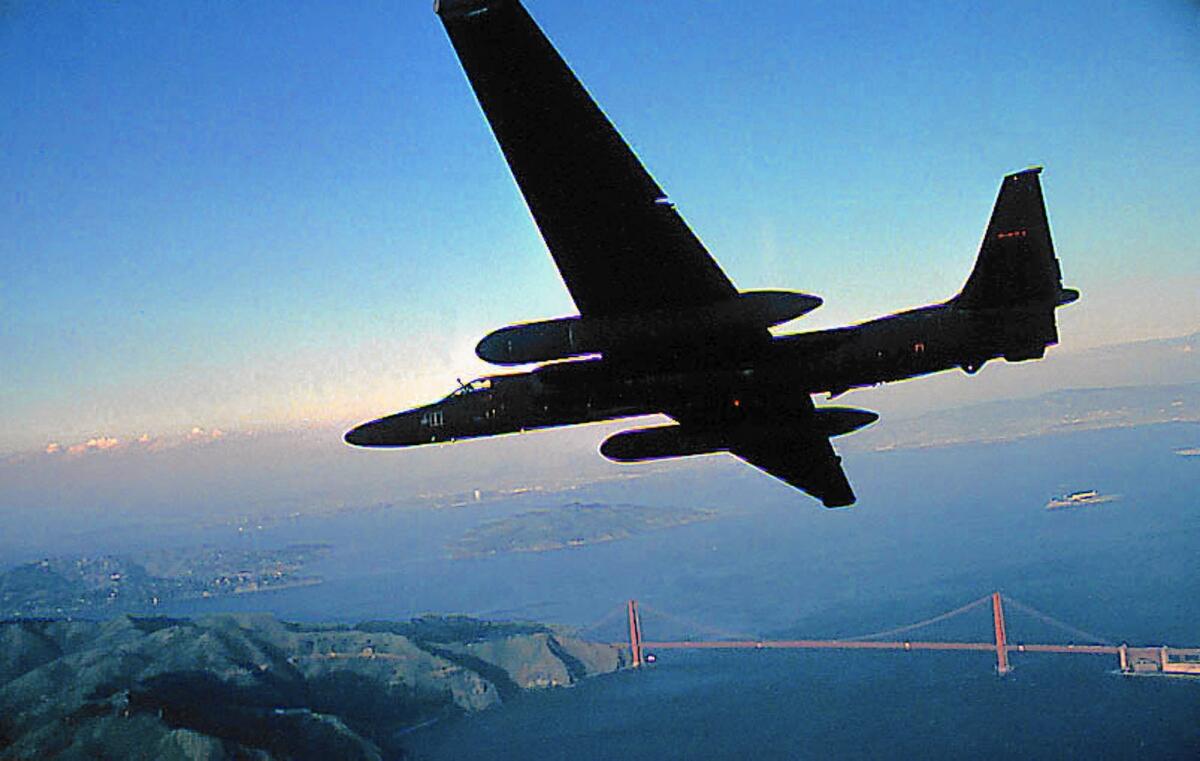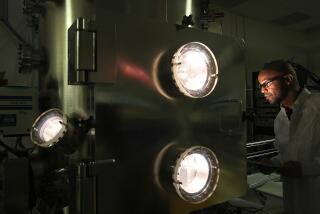U-2 spy plane’s mission: fend off rival Global Hawk

For six decades, the sinister-looking black U-2 spy plane has allowed the Pentagon to see what our enemies don’t want us to know.
With sensors that can pinpoint landmines from 13 miles high, the plane has played a key role in U.S. intelligence gathering since its first flight on Aug. 1, 1955.
But as manufacturer Lockheed Martin Corp. celebrates the plane’s 60th year, the company is losing the battle against its retirement. The Pentagon says it is planning to end the sleek spy bird’s daily sorties in 2019.
At a giant hangar in Palmdale where the plane is refurbished, Lockheed executives on Tuesday said they had no intention of seeing the U-2 relegated to its display in the Smithsonian.
SIGN UP for the free California Inc. business newsletter >>
They say the glider-like spy craft nicknamed the Dragon Lady can fly until 2045.
“When we say we’re going to fly, we fly,” said J. Scott Winstead, Lockheed’s U-2 strategic business manager, of the plane’s reliability.
But in another hangar just miles away, competitor Northrop Grumman Corp. is already working to modify its enormous highflying drone, the Global Hawk, to carry the U-2’s sensors.
Both aerospace firms lease space at the sprawling expanse of Joshua trees and sagebrush in the Mojave Desert known as Air Force Plant 42, about 60 miles northeast of Los Angeles.
Last month, Northrop won the right from the Air Force to equip two of the bulbous-nosed drones with adapters that may soon allow them to fly with some of the U-2’s key sensors — which if successful could eliminate the need for two spy planes.
Mick Jaggers, Northrop’s Global Hawk program director, said this week that the Global Hawk is cheaper to operate and flies closer to the ground, giving the Pentagon even more refined intelligence.
“We bring an advantage,” Jaggers said. “We fly closer to the target we’re trying to capture.”
But being able to cruise for 12 hours at 70,000 feet — twice the altitude of a commercial jet — is one of the reasons the U-2 has served the Pentagon so well.
Executives say the plane is now flying at least 17,000 hours each year, twice as many hours as 20 years ago.
“There is always an airframe in the sky,” said Melani Austin, Lockheed’s U-2 program director.
Added Winstead: “If it’s in the news, and there are hostiles in the area, you can bet the U-2 is there.”
Secretly designed in Lockheed’s Skunkworks research lab in Burbank during the Cold War, the plane was built to find missiles behind the Iron Curtain.
Lockheed engineer Clarence “Kelly” Johnson fashioned it as a jet-powered glider with long, narrow wings that were a third of the normal weight at the time.
Johnson delivered the first plane to the Eisenhower administration’s Central Intelligence Agency just nine months after signing the contract. The company built the initial 20 planes for less than their budget, returning money to the government.
The public found out about the plane in 1960 when it was shot down by the Soviets. Pilot Francis Gary Powers was held by the Soviets for two years.
Winstead remembered Tuesday how the U-2’s first flight in 1955 was actually a mistake. The plane was on what was planned as a high-speed taxi test, he said, and it just took off. “It loves to fly,” he said.
The spy craft’s slender wings give it enormous lift, but the design also makes it notoriously squirrelly to fly — raising the risks for the single pilot in its tight cockpit.
On the grueling missions, pilots wear spacesuits, breathing from an oxygen tank and eating and drinking everything through a straw. Meals, such as macaroni and cheese with added caffeine, come in a tube.
“We’re worried about staying awake,” said Lockheed pilot Greg Nelson, who previously flew the plane for the Air Force. “It’s a survival contest between you the jet.”
And until Lockheed’s recent modifications, pilots on the longest missions often suffered from decompression sickness — known as “the bends” — like what scuba divers suffer when they surface too fast.
“We had a big problem,” Nelson said, recounting how one afflicted pilot in Afghanistan nearly crashed.
Lockheed has now modified the planes so that pilots feel pressure equivalent to an altitude of about 15,000 feet rather than the 29,000 feet of altitude — the height of Mt. Everest — before the change. The improvements included strengthening the frame and increasing the air pressure inside the cabin.
“We’ve had no pilot injuries since then,” Austin said.
The Air Force now has 27 U-2s and five additional two-seat trainers. The aircraft are not as old as the 60-year anniversary suggests. Most were built in the 1980s, with just two left from a production run in 1968.
Lockheed has 325 employees working full time on refurbishing and maintaining the U-2, most of them in Palmdale. Every seven years, the plane is torn apart, stripped of its wings and then rebuilt.
Northrop assembles the Global Hawk in Palmdale. Jaggers said he is aiming to have a drone outfitted with the U-2’s sensors and ready for tests in less than six months.
Lockheed’s Winstead countered that equipping a Global Hawk fleet with new sensors could eventually cost hundreds of millions of dollars. “Right now the U-2 is bought and paid for,” he said.
Loren Thompson, a defense analyst at the Lexington Institute, which has received funding from both companies, said the two planes “are complementary.”
Global Hawk flights are often canceled because of weather, Thompson noted, while the U-2 flies above the storm.
Thompson said the Pentagon had been threatening for years to retire the spy plane.
“Congress always steps in and prevents it,” he said.
Rob “Skid” Rowe has flown the U-2 as a test pilot for Lockheed for 22 years. He said he intends for that to continue.
“Beat back the robots,” he said.
Twitter: @melodypetersen
ALSO:
Critics of Trans-Pacific Partnership trade deal warn about arbitration clause
NBCUniversal chases a younger audience with BuzzFeed deal
Amgen to pay $71 million to states for promoting off-label drug uses







